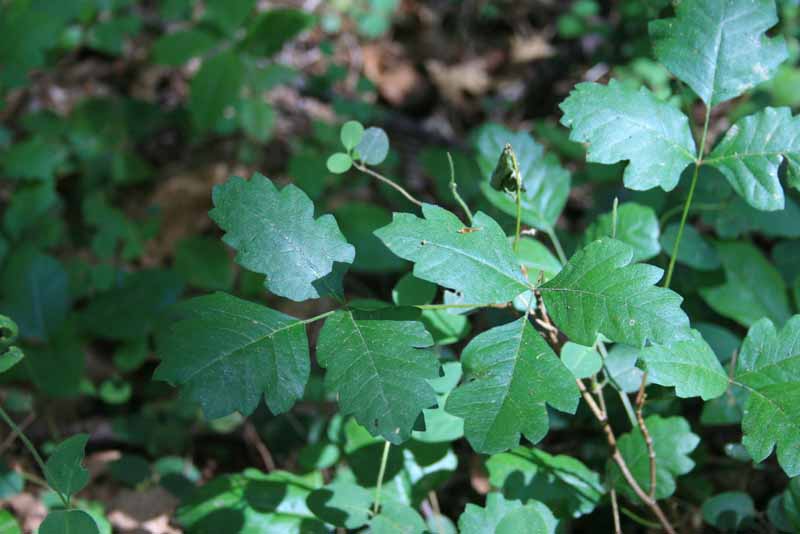
Green stink bug on poison ivy. (C) Jo Ellen Meyers Sharp
In the NCIS episode “Viral,” McGee tells Bishop to be careful because the area they are investigating (outside Washington, D.C.) is covered with poison oak. In fact, there have been warnings about poison oak in several “NCIS” episodes.
Those California-based writers probably don’t realize that poison oak (Toxicodendron diversilobum) is rarely found outside the western United States. The leaves of this native plant resemble oak leaves, which accounts for its common name. It can be a vine or a shrub.

Poison oak. Photo courtesy US Forestry Service
There is Atlantic poison oak (T. pubescens), a native vine or shrub-like plant. Although uncommon, it is found in Illinois and states south and east, but not in Indiana.
Much more common in the eastern half of the U.S. is poison ivy (T. radicans). It’s so common that we frequently find this native plant in our yards, whether we live in urban, suburban or rural areas. Poison ivy can take the form of a climbing vine or as a shrub. The most identifying characteristic is “leaves of three, let it be.” It has beautiful fall color and showy berries.

Poison sumac. © Troy Evans /Bugwood.org
Poison sumac (T. vernix) also can be found in Indiana, especially along riverbanks or swampy areas, where it grows as a shrub or small tree. Its leaves are opposite each other on slightly arching branches.
Poison ivy, poison sumac and poison oak all contain urushiol, an oil that causes the rash or welts associated with exposure to these plants.
Another native plant, Virginia creeper (Parthenocissus quinquefolia) is sometimes mistaken for poison ivy, primarily because the leaves look similar. But Virginia creeper has five leaflets to a leaf and it climbs by tendrils and suction cup-like appendages. It has purple fruit and beautiful fall color. The leaves and stems of this plant contain crystals of calcium oxalate, called raphides, which can cause dermatitis on some people.

Virginia creeper scampers over cheddar pinks. (C) Jo Ellen Meyers Sharp
What’s a gardener to do? I always wear long sleeves, jeans and gloves when pulling Virginia creeper from my neighbor’s fence or other places in my yard. If I find poison ivy, I cover my arm with several plastic sleeves that newspapers come in. I pull the poison ivy, then pull the plastic sleeve over my hand and toss bag in the trash.
There are products you can apply that provide a barrier to these plants’ irritants. And if skin is exposed, there are specialized products to clean the area. Your pharmacist can make recommendations. Always read and follow the label directions.
Remember to use care when taking off clothes worn when working with these plants. The oil can remain on the material and be transferred to your skin. Consider washing garments that were exposed to the oils twice.